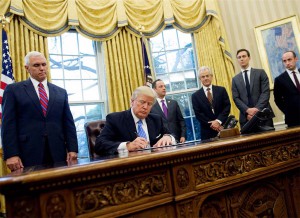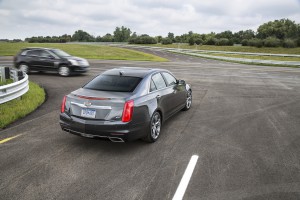
The Trump Administration killed another Obama-era regulation requiring vehicles to be able to communicate with one another.
The Trump Administration has killed off another Obama-era regulation, this one meant to use wireless technology to allow vehicles to “talk” to one another, sharing information about highway conditions and weather.
Ironically, the move comes at the same time Congress is considering legislation meant to promote the development of autonomous and driverless vehicles. But vehicle-to-vehicle, or V2V, technology is seen by some as essential for tomorrow’s self-driving vehicles as it will help them keep tabs on what’s happening on the road around them, such as a situation where another vehicle runs a red light.
Combined with other smart vehicle technologies, the U.S. Department of Transportation had estimated V2V – and similar vehicle-to-infrastructure communications systems – could prevent or reduce the severity of as much as 80% of collisions that occur on U.S. roadways.
V2V technology is one of the “most important tools” the auto industry could bring to production, said Deborah Hersman, president of the National Safety Council.
And a number of automakers appeared to agree. General Motors has begun integrating a V2V system into some of its new Cadillac products. Audi is also using V2V on some new models and demonstrating its potential in a partnership with Clark County, which covers suburban Las Vegas. That program alerts a motorist to the timing of many of the county’s stoplights, ticking down to when they will change to red or green, so motorists can brake or accelerate more smoothly.
Just before the Obama Administration closed up shop, the Department of Transportation announced preliminary approval not only for the V2V mandate but also several of its own pilot programs, including one creating an experimental grid covering about a 100 square-mile section of suburban Detroit. Motorists traveling along parts of U.S. 23 near the college town of Ann Arbor have been coping for months with construction as the necessary hardware, including active roadside signage, is being installed.
(New legislation attacks cyber security. For the story, Click Here.)
The Trump Administration has been taking active steps to roll back federal regulations, especially those enacted during the Obama year. According to the Associated Press, two unnamed auto industry officials were advised by the White House and DoT that the V2V mandate would be dropped. The decision, the wire service added, was being made at “higher levels of the administration.” While the administration declined comment, the proposal has been dropped from the Office of Management and Budget’s list of regulations currently being developed.
While automakers may choose to continue installing V2V and V2I devices in their vehicles, NSC’s Hersman warned that “The only way you’re going to get it adopted and deployed in a widespread manner is by having a mandate.”
Hersman and others have pointed to the fact that, after more than a decade, U.S. highway fatalities have been on the rise over the last several years. Experts blame a variety of factors, including distracted driving. V2V could help, they claim, by alerting drivers when, for example, another car runs a red light or when a driver turns the wrong way on a freeway.
“The longer we wait, the more people die,” Kirk Steudle, director of the Michigan Department of Transportation, told the AP. “We need to move forward with it.”
(Click Here for details about the fed’s plan for V2V technology.)
The V2V rules did generate some opposition from within the auto industry, a handful of manufacturers saying they were wary of the cost of the hardware – though the industry was generally receptive.
“This rule would have imposed large public infrastructure costs, in addition to the substantial costs on every American who purchased a new automobile,” said a statement issued Wednesday by the Competitive Enterprise Institute, a Conservative think tank that takes a generally negative view towards most government regulations.
Opposition to the V2V mandate had also been raised by the telecommunications industry as it pitted wireless and cable providers against the auto industry in a battle for increasingly rare open space on the broadcast spectrum. The feds had been planning to use the 5.9 GHz band for vehicle communications systems, but those in the communications and tech industries wanted it for their own needs. The Federal Communications System had been running tests to see if that portion of the spectrum could be safely shared between cars and other users. It’s unclear if the FCC will now complete the testing.
V2V tests are also underway in Europe and Japan.
(To see more about the rising demand for cybersecurity experts in the auto industry, Click Here.)
The DoT mandate would have called for V2V technology to be installed in half of all new vehicles within two years of its final approval, and 100% within four years.


Trump’s obsessed with killing anything Obama did, instead of thinking (probably stupid to expect him to think deep thoughts) about what benefits industry and the country.
Light up the switchboards!
That is a term of art meaning you and people you know telephoning your Member of Congress and the Senators representing your state. Most Senators and Members of the House of Representatives (Congressmen or Congresswomen) have staff members answering the phone to hear from constituents on important issues such as this. Give your name, where you are from, and politely and concisely explain what you are concerned about and why.
You can also e-mail — phone and e-mail is the preferred way to be in contact with Congress. That people are contacting them on an issue is a great motivator to our representatives who are both interested in their own reelection, but justifiably so in that it is in their interest to represent their constituents.
There are issues where there is a partisan divide. Here, for the government to allocate scarce radio spectrum for cars to avoid traffic jams, to reduce traffic jams by having cars flow better through traffic lights and to save lives by avoiding crashes, such could have broad-based support.